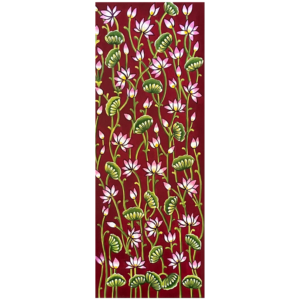Pichwai
Pichwai is a traditional Indian art form originating from the town of Nathdwara in Rajasthan, known for its vibrant depictions of Hindu deities, especially Lord Krishna. The term “Pichwai” derives from the Sanskrit words “piccha” (back) and “wai” (hanging), referring to the large, intricately painted cloth hangings that were originally used to adorn the walls of temples and shrines.
Pichwai paintings are characterized by their meticulous craftsmanship and rich symbolism. The art form features elaborate scenes from Krishna’s life, including his divine pastimes, beloved deities, and the lush landscapes of Vrindavan. The paintings are created using natural colors derived from minerals, vegetables, and precious stones, and are often adorned with intricate patterns, gold foil, and detailed embroidery.
The compositions are distinguished by their symmetrical arrangements and vibrant color palettes, typically showcasing Krishna in various forms, such as the playful child, the romantic lover, or the regal king. Each scene is carefully designed to convey spiritual themes and devotion, often including symbolic elements like lotuses, peacocks, and cows that highlight the divine nature of Krishna’s life and teachings.
Pichwai art is not just an artistic expression but a deeply spiritual practice, reflecting the devotion of the artists and the rich cultural heritage of Rajasthan. Each piece is a celebration of divine love and devotion, meticulously crafted to inspire reverence and awe in its viewers.
Showing all 3 results
-
Divine Harmony: Krishna’s Sacred Embrace
Original price was: $499.00.$199.00Current price is: $199.00. -
Sale!
 Out of stock
Out of stock
Heavenly Revelry: The Divine Pastimes of Krishna
Original price was: $499.00.$199.00Current price is: $199.00. -
Radiant Devotion: The Enchantment of Krishna
Original price was: $499.00.$199.00Current price is: $199.00.


